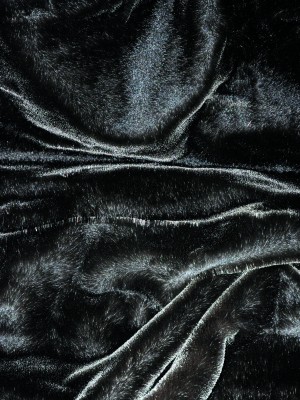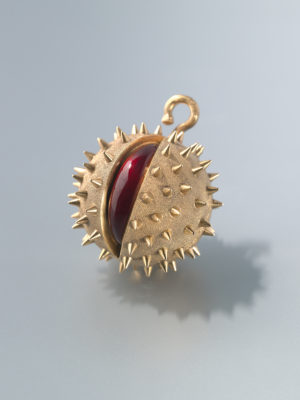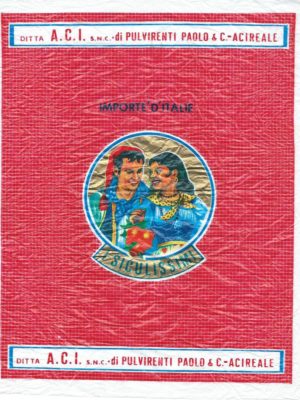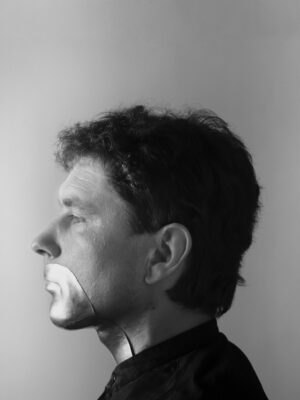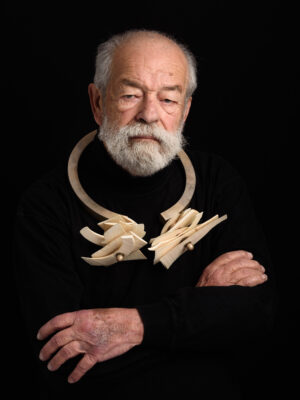
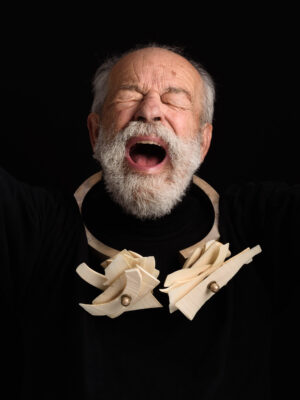
The Biennial’s general curator, Cristina Filipe, comments: In the face of fear and a threat that is currently all over the world, how do we connect to the objects that give us the feeling of protection? What comes from that is a link to an object, to the memories of an object—be it considered divine, blessed, or magical. A lot of people are thinking about this right now—connecting fear, body and the material world through jewellery with this focus, or through amulets to give confidence to the wearer. Fear is not new, but the challenge today is to bring to the table the way people deal with this feeling in their lives; the context being not only the pandemic. By bringing different artists, researchers and thinkers that talk about this experience in totally different ways, we want something personal and something human to be revealed.
The Biennial is the brainchild of the Portuguese Contemporary Jewellery Association (PIN) organised by Cristina Filipe, Marta Costa Reis, Isa Duarte Ribeiro and Luís Torres, along with other PIN members, namely the honorary Madalena Braz Teixeira and Gonçalo Vasconcelos e Sousa of the scientific committee. The Biennial’s extensive programming includes talks, meetings, masterclasses and exhibitions at several key museums and galleries—all revolving around subjects of the body, fear and protection.
‘What comes from that is a link to an object, to the memories of an object—be it considered divine, blessed, or magical.’
The central theme of the Biennial emerged from a March 2020 exhibition project by PIN and MUDE (Museu do Design e da Moda / Museum of Design and Fashion), dedicated to protective jewellery objects for the 21st century. A selection of those same works among others will be presented at the Biennial in a core exhibition in partnership with MUDE, Museu de São Roque (Sacred Art Collection) and the Museu da Farmácia (Pharmacy Museum). Museu de São Roque and Museu da Farmácia will exhibit contemporary works in dialogue with pieces from its collection, namely reliquaries, and bezoar stones respectively. Cristina Filipe invited the Jesuit priest João Norton de Matos SJ to co-curate the show and Fernando Brizio to design the exhibition.
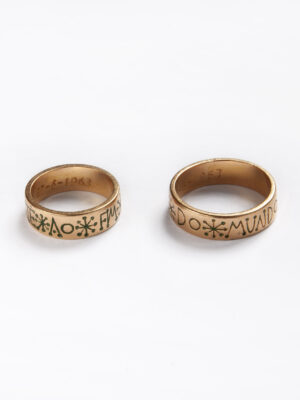
MUDE will also present at Sociedade Nacional de Belas Artes (SNBA) an Anthological Exhibition of jewellery created by renowned Portuguese sculptor José Aurélio, curated by the art historian Laura Castro and designed by Filipe Alarcão. To attract collectors and the general public, the SNBA will also host a Jewellery Room with several international galleries specialising in contemporary jewellery such as S O, Viceversa, Door and Alice Floriano.
One of the Biennial’s primary goals is to create dialogue through time—to showcase significant historic pieces with rich references while drawing from the work of contemporary practitioners to highlight socio-political issues.
For instance, the Precious Crown of Our Lady of Fatima will be displayed for two days in October at the Igreja de São Roque as part of the Cold Sweat exhibition. Accompanying this historic object will be a colloquium on the history of the Precious Crown with several guest experts, namely Marco Daniel Duarte, the director of the Shrine and Museum of Fatima; the gemmologist Rui Galopim de Carvalho, who has intensely studied the three thousand stones and pearls integrated into the crown; and Jorge Van Zeller the director of Casa Leitão & Irmão, the jewellery house who made the crown in the 1940s moderated by the museologist Madalena Braz Teixeira.
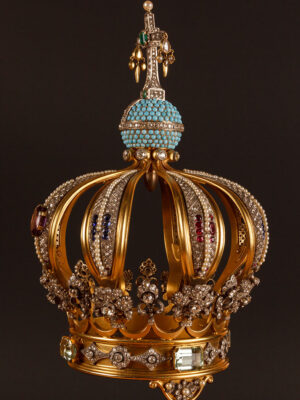
The Precious Crown and its place of exhibition, the Igreja de São Roque, have deep connections to our need for protection in our current times. The church itself was conceived for the Black Plague pandemic and was used as a shelter. The Crown was made out of several jewellery pieces donated to the Shrine of Fatima by a group of women after the Second World War, to give thanks to Portugal. Portugal had been protected by the government’s decision not to get involved in Second World War, but the women believed that it was Our Lady of Fatima who protected the country. Later, in the 1980s, the projectile aimed at Pope John Paul II was offered as a contact relic to the Shrine, who ordered local jewellery makers to integrate it into the Crown. Upon receiving the order, the jewellers realised there was already a spot in the Crown’s structure with precisely the same diameter as the projectile, making it easy to mount it in the centre of the Crown. The Crown, therefore, became a reliquary for this projectile —an element touched by Saint John Paul II.
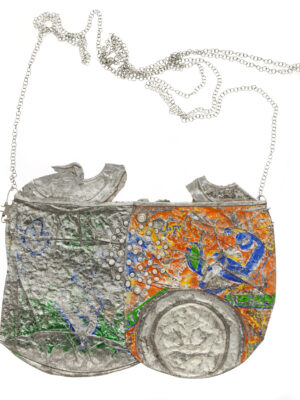
Israeli jewellery artist Deganit Stern Schocken is a contemporary practitioner whose work enters into dialogue with such historical reliquaries. Her practice of creating peace-promoting artistic interventions from found objects and ready-mades from the Palestine-Israel border (Kalandia military checkpoint) is very much connected to the traditional practice of creating protective reliquary amalgamations such as those at the Museu de São Roque where is going to be on display.
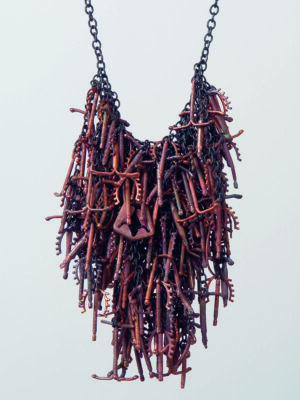
Likewise, Norwegian artist Nanna Melland’s necklace 687 Years was selected to reflect on protection. A long iron chain gathers a diverse set of intrauterine devices (IUDs) used by countless women in different periods to prevent pregnancy and collected by the artist with the support of several doctors and institutions. These small plastic objects, with their copper spirals, bear witness to the many challenges concerning human procreation throughout history and reference the talismans used to protect and promote fertility across cultures.
Cristina Filipe chose to present this 2006-2008 necklace, which is part of the collection of the Nordenfjeldske Museum in Norway, as a diptych next to a selection of Foundling Tokens from the Historical Archive of Santa Casa da Misericórdia de Lisboa (SCML). The tokens would have been folded into swaddles by families who left their children in the Foundling Wheel of Lisbon between 16th and 19th century at SCML; a rotating door-like device that protected the anonymity and dignity of parents who couldn’t raise their child. They would place the child into the wheel and turn it, safely surrendering their child into the care of the orphanage. The tokens mostly consist of a note in which the parent recorded information regarding the child’s identity. Unsurprisingly, these objects were often jewellery pieces—elements of talismans, charms broken in two with hopes of meeting again and proving the relation. These artefacts will be shown in Cold Sweat alongside other works that reflect the body, fear and protection, such as the ones made during the lockdown project.
The artists in lockdown project features the works of Tereza Seabra, Catarina Silva, Manuela Sousa, Dulce Ferraz, Ana Albuquerque, Zélia Nobre, Filomeno, Lúcia Abdenur, Márcia Cirne, Paula Castro, Inês Nunes, Teresa Dantas, Diana Silva, Marília Maria Mira, Carla Castiajo, Pedro Sequeira, Typhaine le Monnier, among many others. Catarina Silva’s Apotropaic Amulet necklace was made with mirrors, glass beads, bone and cotton braid during the lockdown project, and also continues the practice of searching among past amuletic or talismanic rituals for inspiration when creating objects of protection for the 21st century. Under fear of death, amidst the simultaneous repulsion and attraction of the unknown, something magical appears.
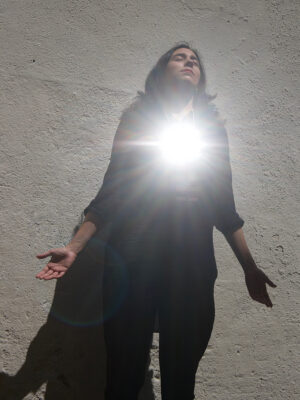
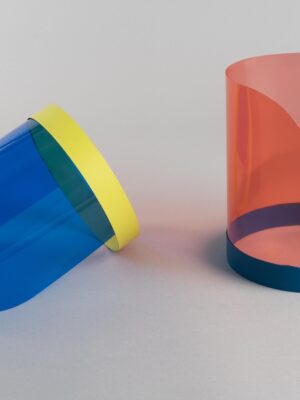
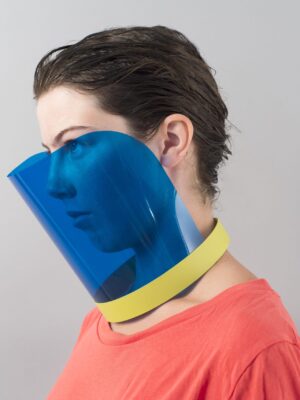
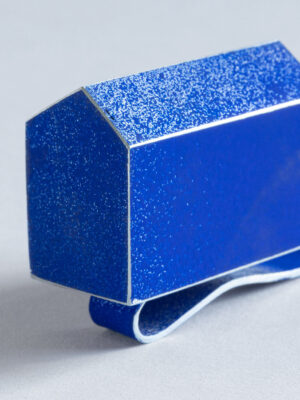
Paying tribute to death, Manuela Sousa created an archive with the names of people who have died during the pandemic, utilising a ready-made protective nitrile glove framed in a pile of sheets, where she eternalises the list, almost as a poem. This protective glove, as a relic of contemporary times, dialogues with Visor by Typhaine Le Monnier, a redesigned face-shield-turned-neckpiece that transforms a newly commonplace protective item into a memorial for the tragic circumstances that made it so commonplace.
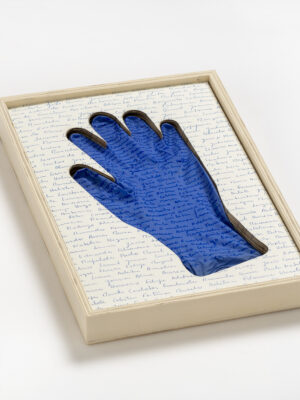
The Museu da Farmácia, another partner institution, has a beautiful collection of historical protective objects that demonstrate how different countries and cultures have dealt with health and protection will launch few artists in context. Reflecting on contemporary wellness culture, Switzerland-based jewellery artist Christoph Zellweger is developing a Cabinet of Risks & Chances, a new work that integrates jewellery elements related to supplements, vitamins and ‘remedies or superfluous stuff, almost invisible substances that are designed to change our lives.’
Meanwhile, Sweden-based artist Agnieszka Knap will present a new development of her performative project Dr. Knap, Qualified Jewellery Artist.
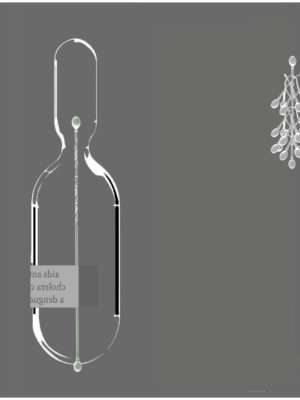
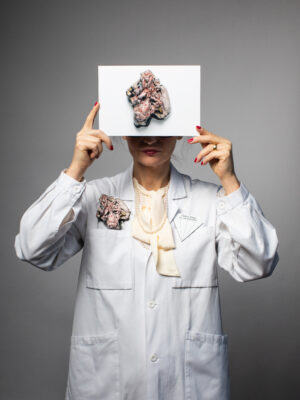
These are just a few examples of how the Lisbon Contemporary Jewellery Biennial aims to provoke a real debate about the body, fear and protection in different contexts: philosophical, scientific and artistic. They look forward to producing content and encouraging us to consider the roles of jewellery beyond that of a showpiece. The Biennial is a rigorous two-year journey of reflection into subjects that illuminate moments in history as they relate to our present, spark debate and prove that art and artists play an integral role in helping us to understand our world and our place within it.
‘Under fear of death, amidst the simultaneous repulsion and attraction of the unknown, something magical appears.’
The Lisbon Contemporary Jewellery Biennial urges us to ponder the complex moment we are all living through and encourages us to take a closer look at jewellery history-to make connections with other subjects, to cultivate contemporary jewellery by creating new settings for exhibitions and to promote meaningful exchanges between researchers, curators, artists and students, as well as the Portuguese and international public.
The Biennial is inspired by the concept of what we feel we need to use as protection—a kind of object, a kind of jewellery—but expands also into the realms of what fear is, what protection is, what the body is, —concludes the artistic director Marta Costa Reis.
COLLOQUIUM BODY FEAR AND PROTECTION in partnership with the Research Centre for Science and Technology of the Arts at the School of Arts – Catholic University of Portugal, invites twelve international researchers from different fields to debate the central topics of the Biennial in three days of lectures. The director of MUDE, Bárbara Coutinho, Dutch art historian Liesbeth den Besten and Brasilian researcher Ana Paula de Campos will reflect on Body, moderated by the painter João Paulo Queiroz. The researcher Rosa M. Mota will talk about Fear through a reflection on traditional Portuguese jewellery artefacts, with the theological viewpoint of João Norton de Matos SJ and the art historian perspective of Alena Alexandrova, moderated by the artist Kadri Mälk. Denis Bruna from MAD in Paris will talk about Protection with the director of the Museu da Farmácia, João Neto and the art historian Gonçalo Vasconcelos e Sousa, moderated by the V&A museum curator Kirstin Kennedy. It will take place at Brotéria the beautiful Jesuit cultural center in the heart of Lisbon next door to the church and museum of São Roque. Early Bird Registration until 1 May at www.jewellerybiennial.pin.pt/en
SCHOOLS ENCOUNTERS EXHIBITIONS: The Jewellery Department of Ar.Co–Centro de Arte e Comunicação Visual (Ar.Co) in Lisbon will develop a project based on the Biennial’s theme and present an exhibition of results. This project is a collaboration between eight international schools including the Hochschule für Kunst und Design Halle at Burg Giebichenstein, Central Saint Martins, École Nationale Supérieur d’Árts from Limoges, Eesti Kunstiakadeemia, Lucerne School of Art and Design, PXL-MAD School of Arts and Saint Lucas School of Arts Antwerpen. The Goldsmithing Department at the Escola Artística António Arroio in Lisbon, will also join this project with Brazilian jewellery school Atelier Mourão. Collectively, these schools will meet to share ideas and teaching experiences.
MASTERCLASSES: In the week before the Biennial’s official opening, the masterclasses Fear and Protection by professors Christoph Zellweger and Caroline Broadhead will be held at Ar.Co.
Applications open until 1 April. Selection of participants till 15 of April.
Registrations till 1 May.
More info at: www.jewellerybiennial.pin.pt/en
OTHER EXHIBITIONS AT THE BIENNIAL: Local galleries—Brotéria, Sá da Costa, Reverso, Teresa Lacerda and Tereza Seabra—and the Romanian Cultural Institute in Lisbon in partnership with the Assamblage Association will present various international solo and group exhibitions and promote talks and guided visits. They will include work from around the world by groups such as õhuloss from Estonia, Broca from BraziI, a Collective from Colombia curated by Natalia Olarte and Paula Perez, and artists as Ruudt Peters with a solo, Bernhard Schobinger, Iris Eichenberg, Eija Mustonen, David Bielander, Helenna Lehtinen, Volker Atrops, Takayoshi Terajima and Rebekah Frank are just a few in other group shows.
Biennial full programme at jewellerybiennial.pin.pt/en
